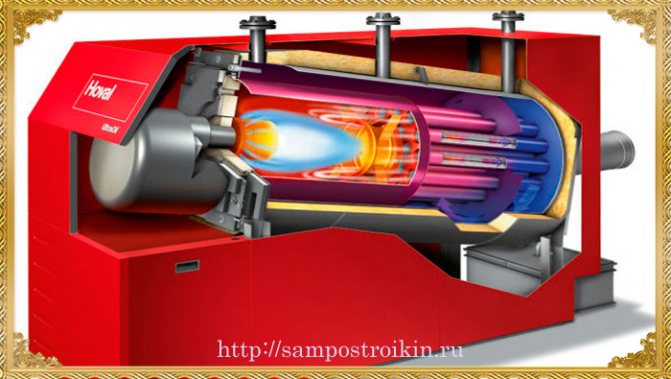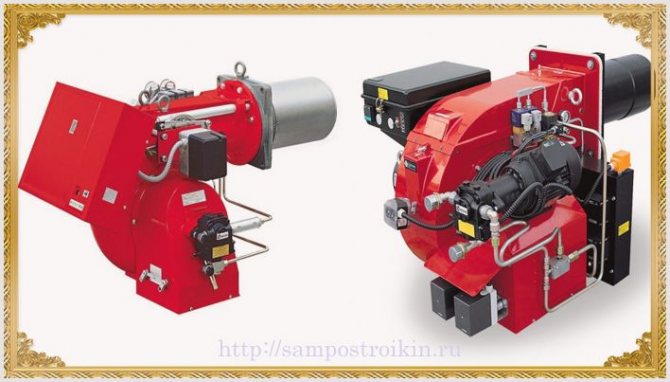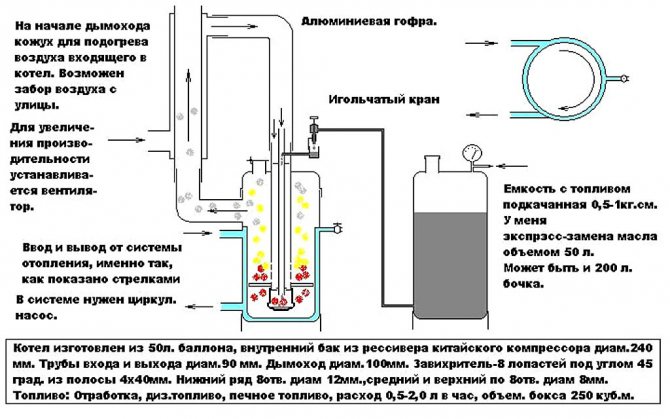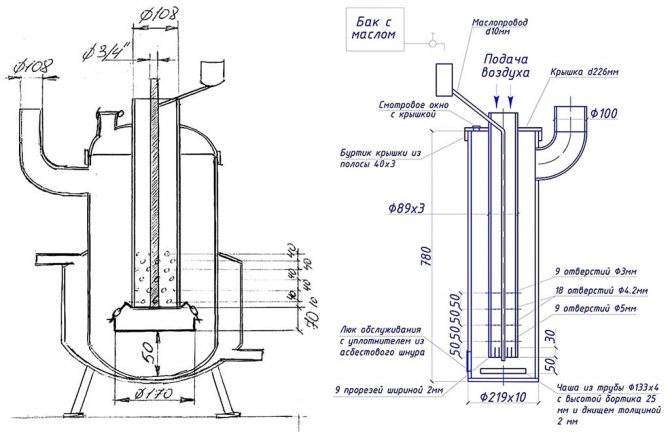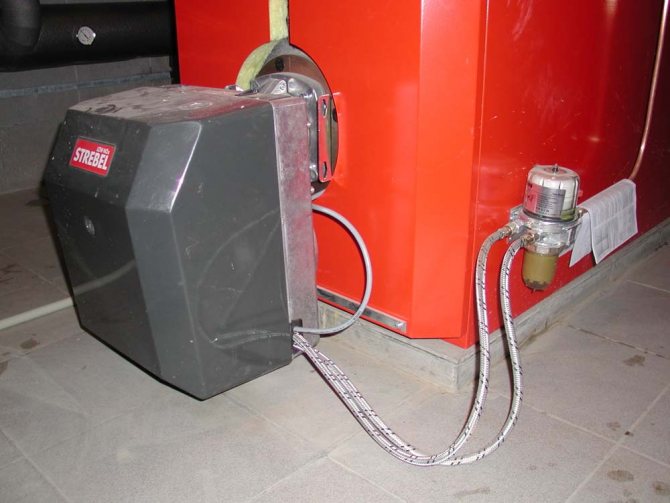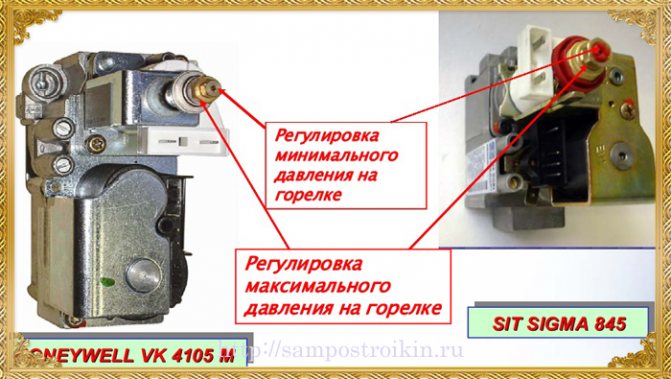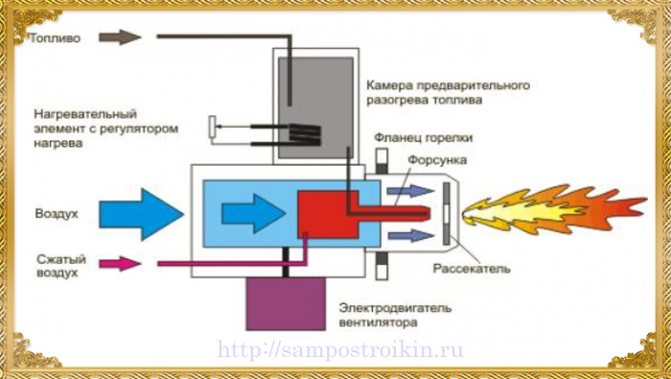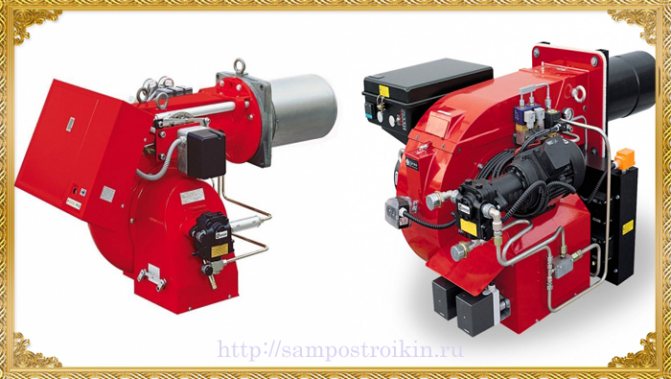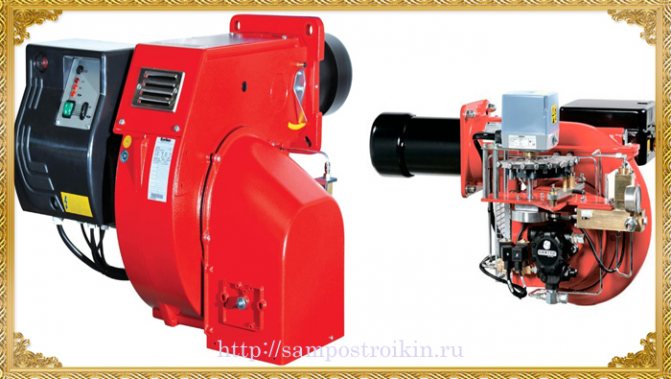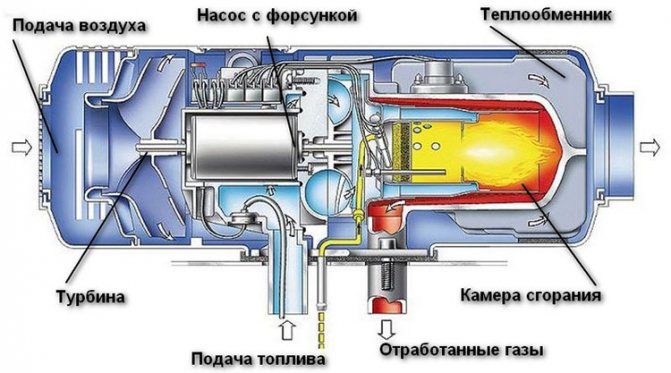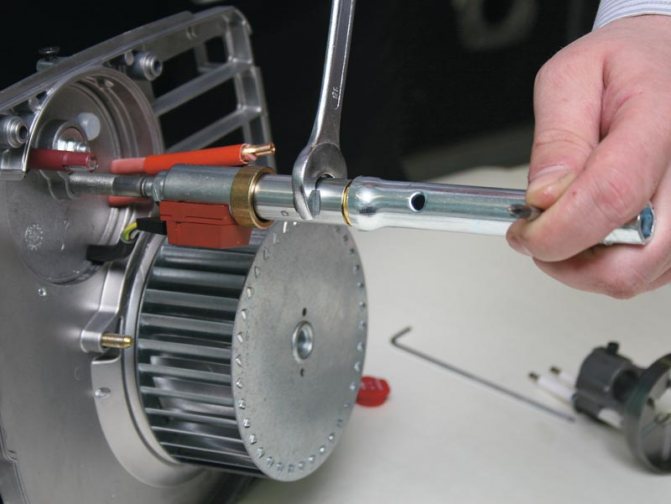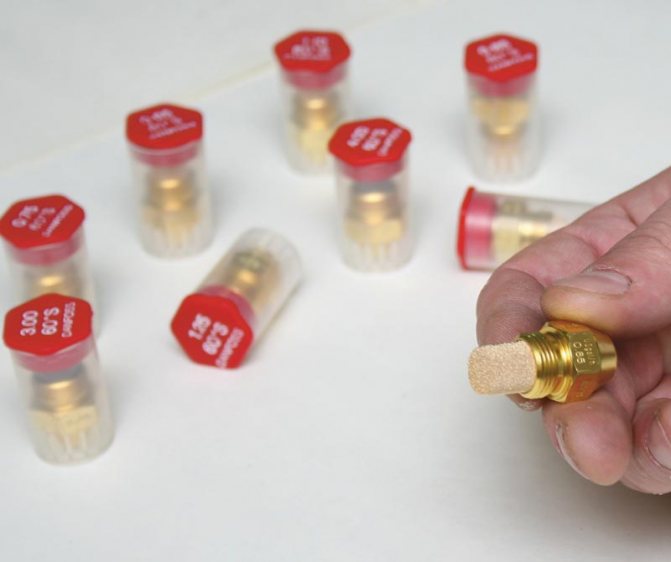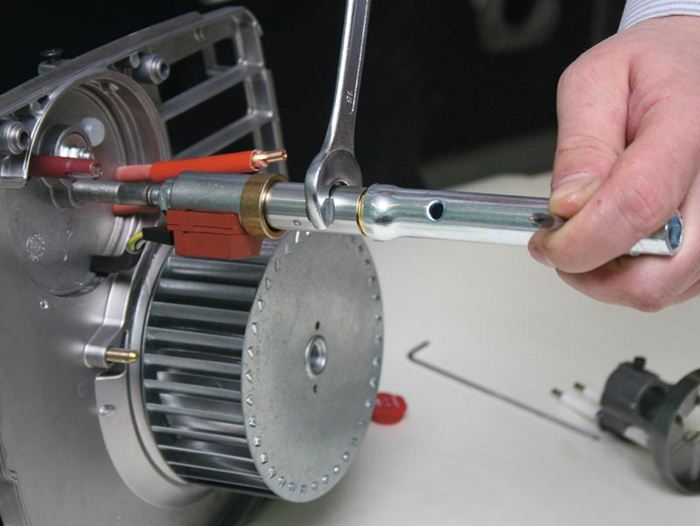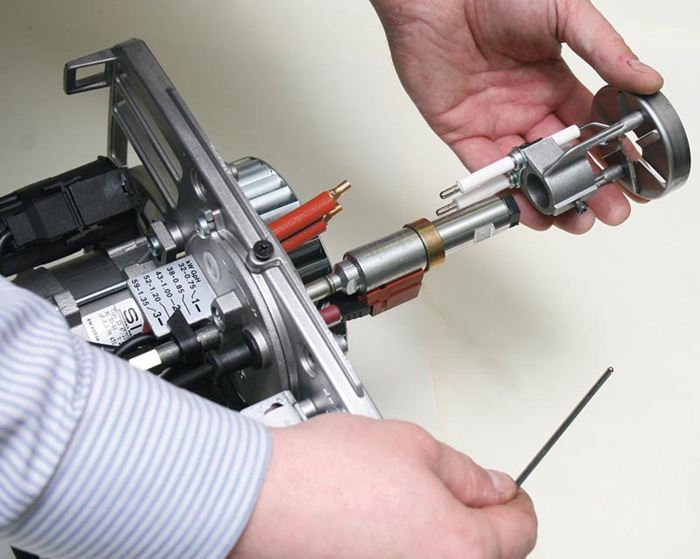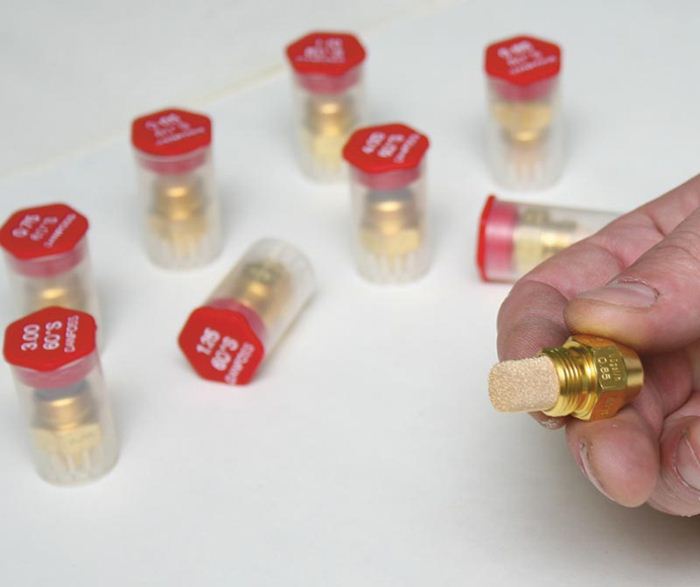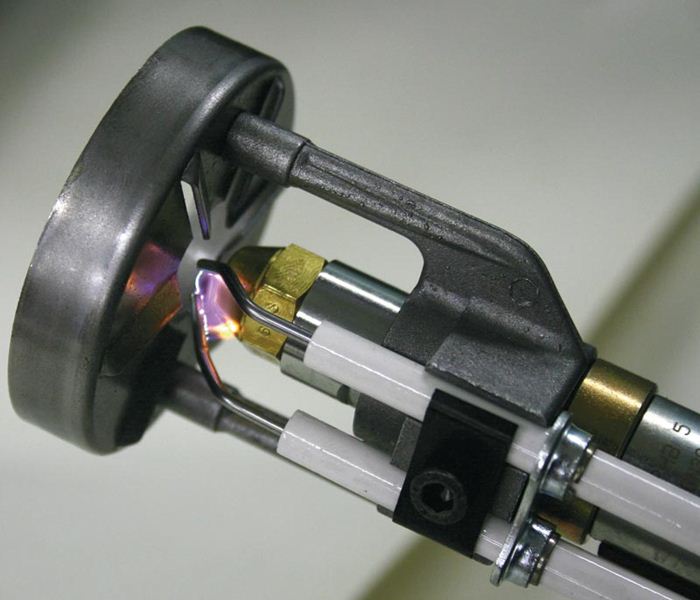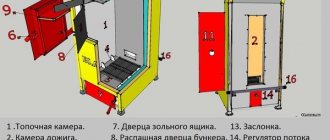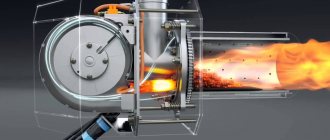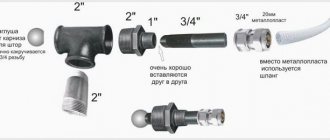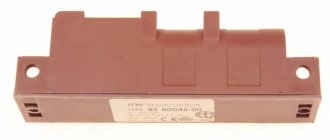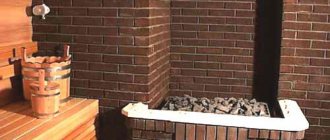The diesel burner is the main device for boilers operating on liquid fuel: fuel oil, oil, diesel fuel or diesel. They usually function in conjunction with an air supply system. The design of such boilers is more complex and less efficient than that of gas boilers; therefore, this type of heat supply source is used in places where there is no central gas supply system. In general, these boilers are capable of achieving high efficiency, have good heat transfer and a reliable safety automation system.
General information
The diesel burner is installed in heating equipment for which liquid fuel is used. In particular, we are talking about heavy oils, for example, working off or diesel. Typically, these burners are paired with floor-standing household and industrial equipment. Often this type of heating is installed where there is no gas main. This is due to the fact that diesel fuel is much more expensive than natural gas, which, in fact, limits its scope and prevalence. In general, diesel boilers are no worse than conventional gas boilers. They have high efficiency, economy, good heat transfer and can be fully automated. In order for the burner to work efficiently, the system must be kept at a constant pressure. Therefore, a compressor is installed, and it is important for it to provide a stable source of energy, which is quite difficult for a number of reasons.
Calculation of the consumption of diesel fuel by the heating boiler
To calculate the consumption of diesel fuel for heating a house, you need to know the rated power of the burner. On average, to generate 10 kW of energy, an average of 1 kg of fuel is required, i.e. when operating in the maximum mode of 24 kW of the boiler, approximately 2.4 kg of diesel fuel will be consumed per hour.
Therefore, it is necessary to very carefully select the temperature mode of heating the coolant and, as a consequence, the degree of heating of the autonomous heating boiler on diesel fuel. If the equipment operates around the clock at maximum power, then at least 29 kg of diesel fuel will be required. Given the increased cost of fuel, this is an unaffordable luxury. To reduce these costs, you can take the following measures:
- Purchase of a modular burner... It is able to accurately regulate the fuel supply level for optimal heating of the coolant;
- Selection of low-temperature operating mode... This not only helps to reduce the consumption of diesel fuel, but also allows you to create an effective water floor heating system;
- Buy radiators with maximum heat dissipation... For them, a heating boiler on a solarium will consume less energy to compensate for heat losses for the passage of heat through the material of the radiator. It is best to install bimetallic models.
Also, the frequency of delivery of diesel fuel for heating plays an important role. It is recommended to install a container, the volume of which will be enough for the entire heating season. In our case, assuming 12 hours of operation of the system, this will be 1.2 * 12 * 90 = 1296 liters.
Experts advise purchasing a container with a margin of 1500 liters. In this case, the delivery of diesel fuel for the heating system can be carried out once a year before the heating season.
Diesel burner for a boiler: principle of operation
Let's take a quick look at how the burner works. From the reservoir, diesel is fed to the burner. To ensure the supply of fuel, a special pump is used, which is equipped with a return line, which is necessary for the circulation of fuel between the pump and the tank.In this case, the burner uses as much fuel as it needs, and the remains are returned back to the tank. But, before the diesel reaches it, it must pass through the filter and the heating element. At the first stage, mechanical elements are removed, at the second, the fuel is heated to the optimum temperature.
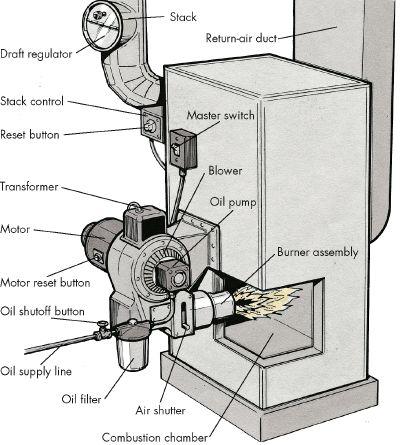
Atomization in the combustion chamber is carried out using a nozzle. At the same time, air is forced through the burner tube. The shape of the torch is controlled by special blades that create an air vortex. Directly in front of the nozzle, electrodes are installed to ensure the ignition of the mixture. This is how a diesel burner for a boiler works. The whole process is controlled by means of automation devices.
Design
A light oil burner must include the following items:
- Filter.
- Fuel pump with pressure gauge.
- Fuel preheating chamber with an electric heater located inside it.
- Nozzle.
- Divider.
- Ignition device.
This set of components is the main one.
In addition to it, there may be other devices in the burner:
- flame sensor: signals the boiler control unit to block the fuel supply when the burner goes out;
- vacuum gauge.
The latter monitors the amount of soot and nitrogen oxide in combustion products.
Briefly about the classification of burners
Currently, manufacturers offer consumers three types of burners. All of them have design features and differ in cost. Therefore, all burners can be divided into the following groups:
- single-stage - operate in 100% power mode without the possibility of adjustment;
- two-stage - you can set the operating mode to 100 or 50%;
- modulated - there are wide possibilities of power regulation, usually it is a range from 10 to 100%.
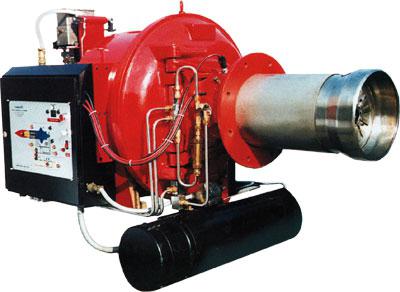

The last option is the most preferable. This is due to the fact that it is possible to smoothly adjust the temperature of the coolant. But along with this, such devices are quite expensive and complicated, therefore professionals must carry out their repair. However, you no longer need to adjust the diesel burners. And this is very important.
Varieties of diesel heat guns
Cannons of this type are also called liquid fuel: they can use both diesel and kerosene or diesel fuel as fuel. It is strictly forbidden to use gasoline, alcohol and other flammable liquids for refueling such devices.
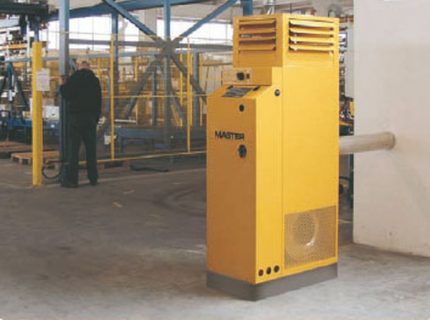

Diesel heat guns can be not only mobile, but also stationary. Such structures have an outlet pipe connected to a chimney through which combustion waste is removed.
The choice of fuel must be approached very carefully, since the use of low quality or contaminated fuel can clog the injector and / or filter, which will require the intervention of repairmen.
Diesel cannons are distinguished by their high power, high efficiency, as well as compact dimensions, due to which such units are quite mobile.
All units operating on economical diesel fuel can be divided into two groups of heat guns: with direct and indirect heating.
Apparatus with direct heating. The operation is based on an elementary principle: a burner is arranged inside the housing, through the flame of which the air blown by the fan passes. As a result, it heats up and then breaks out, giving off heat to the environment.
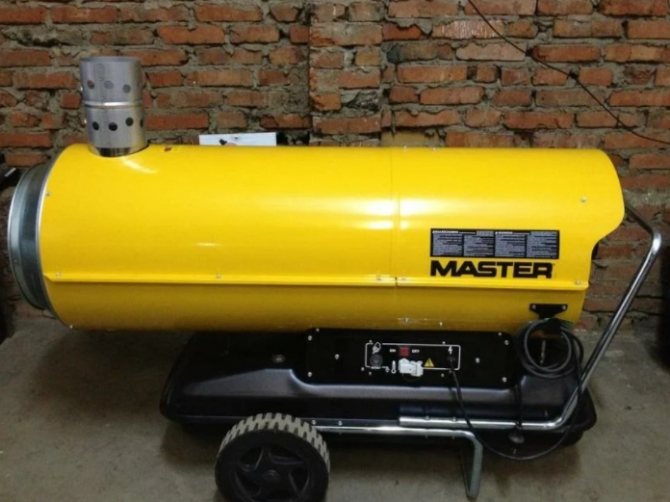

A diesel heat gun with open heating cannot be used for heating residential premises, since its design does not provide for exhaust pipes. As a result, waste substances, including carbon monoxide, enter the room, which can lead to poisoning of the people in it.
Such devices are distinguished by a high power of 200-250 kW and almost 100% efficiency. They are inexpensive, easy to install, but have an important drawback: not only the warmed air stream gets into the outer space, but also combustion products: soot, smoke, burnt.
Even good ventilation will not be able to completely rid the air of the unpleasant odor and the smallest particles, and if it is completely absent, living things in the room can get severe poisoning.
Indirectly heated device much more difficult. In such models, the air is heated indirectly, through a special chamber - a heat exchanger, where heat is transferred to the air flow.
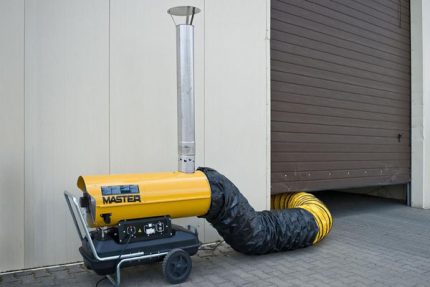

Diesel heat guns with indirect heating have a higher cost and lower efficiency compared to similar products with a direct heat source. However, they are widely used due to the best indicators of environmental friendliness and safety.
In such units, heated exhaust gases, together with the heat, enter the heat exchanger, from where they are discharged into the flue duct, to which a special pipe is connected. With its help, combustion products are removed from the enclosed space to the outside, providing fresh air in the heated room.
Indirectly heated heat guns are often used to heat a garage.


Diesel heat gun models with high power can have large parameters. They are used to heat large premises: warehouses, factory workshops
The advantages of such models include:
- Mobility... Although the dimensions and weight of such devices are somewhat larger than their counterparts with open heating, they are still quite compact in size, which allows them to be transported around the room within the length of the connecting element and the chimney.
- High power... Although this figure is higher for appliances with direct heating, the power of indirect diesel guns is enough to heat a large space in a short time.
- Reliability... Such devices have a well thought-out design, which minimizes the risk of fire, and also increases the durability of the guns.
- Availability of a protection system... In many factory models, a protective complex is provided that automatically turns off the gun immediately after the temperature in the room reaches a predetermined value.
- Reduced risk of burns... Factory-made products are designed with heat-insulating pads to prevent the housing from heating up, which reduces the likelihood of injury to the user.
- Duration of work... On some models, tanks of large volumes are provided, which allows them to be used for a long time without thinking about fuel.
The disadvantage of such structures can be considered a high noise level, especially in high-power units.
Adjusting the oil burners
Often, the adjustment is carried out by specialists, but with the proper desire, adjustment work can be done with your own hands. If a single-stage burner is used, then the work is carried out quite quickly and easily. All manipulations are reduced to the fact that the supply of air and fuel is regulated to ensure normal combustion. In this case, the mixture must be enriched. The quality of the flame is determined by eye. If the setting is made, then you can use a gas analyzer, which will allow you to determine the content of CO and CO2 in the smoke. If the burner "stands", then first of all it is necessary to check the contacts and the operability of the units as a whole and each separately. But the adjustment of diesel burners with the ability to adjust the power (modulated) is quite difficult, and for this you need special equipment.
Varieties of Russian-made waste oil burners
In the cold season, not only residential, but also auxiliary premises need heating.At the moment, devices for heating are used on different types of fuel, including waste or used technical oil. On the Russian market, you can find devices that process different fuel bases, as well as having a narrow specialization. By the type of fuel burned, such devices are:


In terms of functionality, the torches for testing are not only heating, but also welding and lighting
- gas;
- on liquid fuel;
- combined.
The simplest and most economical device for heating a room is considered to be a working burner. In terms of functionality, burners are divided into 3 subspecies:
- welding;
- lighting;
- heating.
The principle of operation of these devices was borrowed from primitive kerosene gas back in the 50s. Quite quickly, the simplest burners became popular, they began to be purchased for heating country houses and garages. In those days, any fuel was inexpensive, but over time, zealous owners, inventors and innovators began to look for a replacement for gasoline, diesel fuel and kerosene. Fuel oil and waste oil were used, which is now used as a full-fledged fuel. Today, the device is still relevant, moreover, it is an excellent way to preserve the environment.
Important! In the room where any liquid-fueled apparatus will be used, whether it is a home-made gasoline burner, an apparatus for testing or a diesel fuel burner with your own hands, there must be a fire extinguisher!
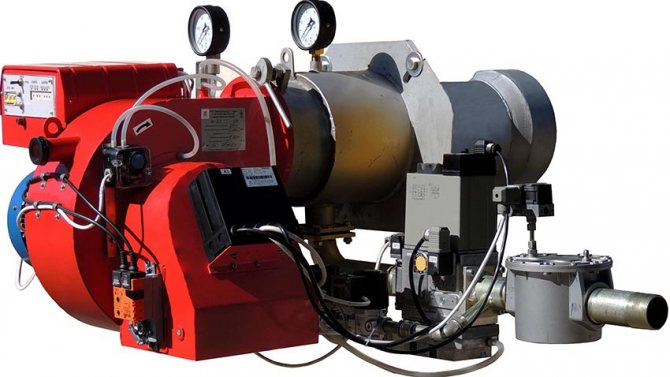

Burners for working out are of the type available on liquid fuel, gas and combined
Making a burner with your own hands
Homemade burners are usually less economical than professionally made burners, so expect to see a 5-10% increase in fuel consumption. Before taking into account, sketch out a sketch and be sure not to forget the dimensions of the firebox and blower. If a one-stage diesel burner is made by hand, then first a monoblock supercharged structure is made. It is advisable to purchase a package of mounting accessories with a housing and a cover for the burner. When doing this, be sure to consider the compatibility of the burner with the generator.
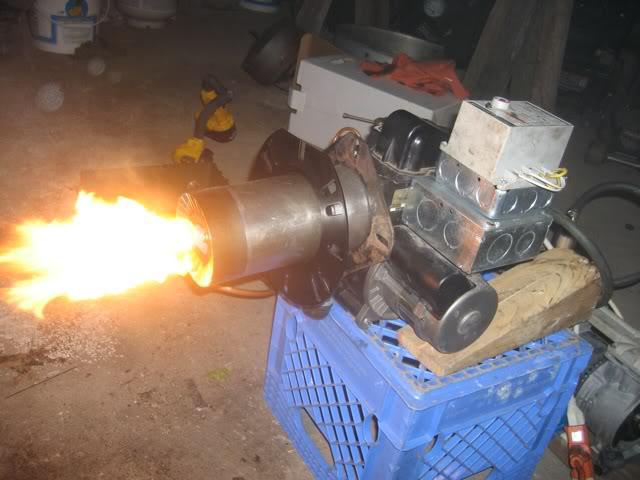

Making a burner with a compressor is more complicated but efficient. A conventional Chinese-made spray gun is suitable as a compressor. So the fuel will be consumed economically, and the quality of the mixture will be at the proper level, and you will have the opportunity to adjust the power of the equipment. If a do-it-yourself diesel burner is made with high quality and reliable, then it will not pose any danger to others.
Metal sheet stove
In short, it looks like two large canned food or discs connected by a pipe with many holes and a pipe for exhausting combustion products at the top. The device consists of two containers connected by a large-diameter pipe (wick bowl) with rows of openings for air intake and flue gas outlet.
Kerosene or diesel fuel from the fuel chamber enters the wick container by gravity. There the fuel heats up - a gaseous mixture is obtained. It goes into the combustion chamber and burns there. A spiral is placed in its upper part, it acts as a heating element and heats up to 800 ° C, combustion waste is removed through the chimney.


A self-made device can be compact in size and has a high level of safety. It is very economical: the fuel mixture and combustible compounds burn out completely. You will need metal sheets with a thickness of 5 mm or more. The pipe has 2 elbows, nested into each other, and is located far from the door. The lower container serves as a firebox and at the same time as a fuel tank; it has an opening for filling fuel. An average such device holds about 2–12 liters of diesel fuel.
Pipe and branch pipe
A hole is created in the upper segment of the structure, a door is attached to it.With its help, the operation of the apparatus will also be adjusted, the supply of air in the required amount, and the force of combustion will be monitored. The pipe and the upper part serve as heating elements. They are capable of heating up to 800 ° C. A branch pipe is welded to the upper part, a chimney is attached to it, which is made of galvanized steel. The top can be detachable for easy cleaning.
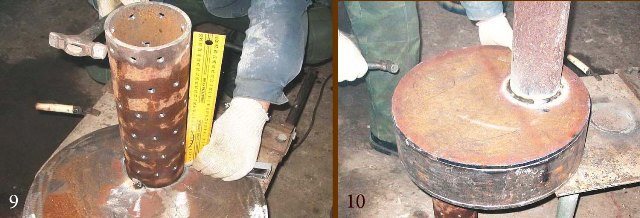

The bottom of the top segment is created from a 6 mm sheet of metal. A round piece of 35.2 cm is cut out of it. A 10 cm hole is made on it, not far from the edge. Between the middle of the circle and the hole there should be about 11 cm, where the pipe and the hood will be inserted. The branch pipe is a piece of pipe 13 cm long and 10 cm in circumference.A rectangle 7 * 33 cm is cut from the same sheet of metal.It will be a partition, it is welded to a 35.2 cm circle closer to the 10 cm hole. An exhaust pipe is inserted into it.
Burner tube and exhaust pipe
Next, make a pipe for the burner. At the bottom of it, at a distance of about 36 cm, a 48 hole of 9 mm is made. There will be 6 rows of 8 pieces each. The distance between them is 6 cm. This pipe is inserted into the fuel tank cap, it is made of a sheet of metal 4 mm. It should be fixed evenly and tightly, it does not need to be welded. With a grinder and a file, it can be adjusted for the tightness of the connection.


A hole is also made in the tank for an exhaust pipe 16 cm long. The top and bottom of the tank are connected, but not welded. The details just fit very tightly. A ring is put on top for a seal with a diameter of 35.4 cm. The fuel tank is welded to the pipe with holes. You also need to make a damper for the hole for filling with diesel fuel, like the one on the door peephole. At the bottom, four legs are welded from the corner.
Source: x-teplo.ru
As the name implies, this gravity burner is designed for installation in furnaces, boilers, when using diesel oil (diesel fuel), kerosene or heating oil as fuel. In principle, any stove can be adapted for this burner, after a little alteration.
The essence of the alteration lies in the fact that the mixing of the grate into the furnace is installed deaf under (sheet of metal) with the burner and all the draft in the furnace occurs through the center of the burner for liquid fuel (see the drawing of the burner installation in the furnace below), without this condition being met the burner will not work.
The design of a pressureless oil burner.
Below are the drawings of the oil burner.
Fig. 1 General view of a gravity burner for burning liquid fuel.
Structurally, the burner consists of 4 main parts, we will consider each separately.
Fig. 2 The first part of the burner, you can use a piece of steel pipe with a diameter of 219 mm, and a pipe with a diameter of 57 mm is perfect in the middle.
Fig. 3 Second burner part. If you do not find a ready-made mesh, you will have to drill holes, although there will be no problems, the metal is only 0.7 mm.
Fig. 4 Third burner part. An ordinary metal ring.
Fig. 5 Fourth burner part.
By design, we think there should be no problems, it is quite simple. A little about the principle of action.
Operating principle of a liquid fuel burner.
Diesel oil vapors ignite and begin to burn after burning rags or cotton soaked in kerosene are thrown onto the protruding part of the evaporation tank. In this case, vaporization of diesel oil vapors occurs, their ignition and enhanced air suction through small holes drilled in the side surfaces of the upper and lower cylinders.
The combustion process is regulated by increasing or decreasing the amount of incoming fuel. The fuel supply can be regulated with a conventional fuel cock.For precise adjustment, a clamp from a medical dropper is well suited (regulates the supply of medicine to the patient). Fuel supply must be carried out, of course, with the help of a flexible gas-resistant hose.
An important issue is fuel consumption. The average fuel consumption of this burner is 0.2-0.4 liters per hour.
A little about the power of this burner. When using this burner in an ordinary metal heating boiler, in the winter period of time and the area of the heated room is 240 square meters (as an experiment), the burner could not overpower heating the water in the heating radiators above 50 degrees. But it is not intended for this, but it is quite suitable for heating country houses, small residential buildings.
Diesel burner repair
If you decide to carry out repair work with your own hands, then stock up on rags, since this is not the cleanest job. The first step is to make sure the oxygen passes through the nozzle. It often happens that it clogs up, and the mixture is not enriched, as a result of which the quality of the torch decreases. If the nozzles are clean, look at the filter. If it needs to be replaced, do so. In addition, if used oil is used, it is quite possible for the channel to become dirty. It must be blown out with compressed air, after draining the fuel from the hose. In principle, the repair of diesel burners is limited to this. Sometimes it makes sense to check the condition of the electrodes. If mechanical damage or wear is noticed, then it is better to change the part or assembly.
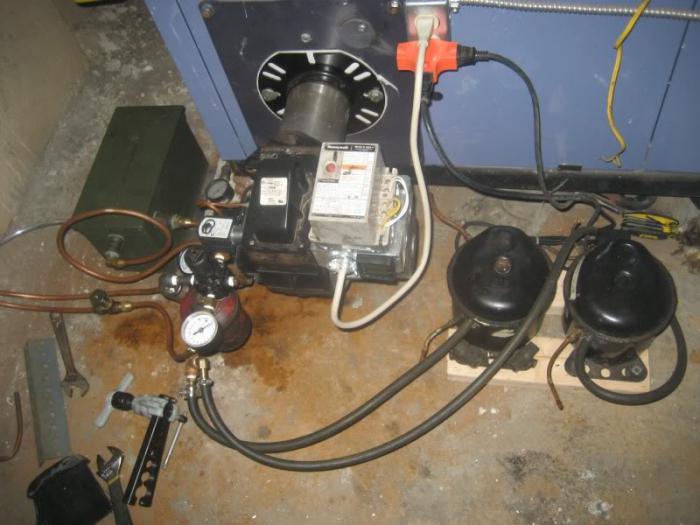

Device diagram
The main element of a Babington burner is considered to be a hollow part with an inclined or spherical surface, with a hole about 0.3 mm in diameter in the very center. The fuel is pumped with a lower pressure to this surface and flows over it, so that a thin film forms on the part.
Inside, compressed air is supplied to the part by a compressor (pressure - from 2 to 4 atm), which comes out through the smallest hole. At the same time, it tears off a certain area of the oil film from the spherical surface, simultaneously organizing the flow of the fuel-air mixture.
All that remains is to set it on fire so that the Babington burner will start working and start making heat. Ignition is carried out, as in a conventional burner, with the help of a spark. To do this, a homemade burner must be equipped with a car candle.
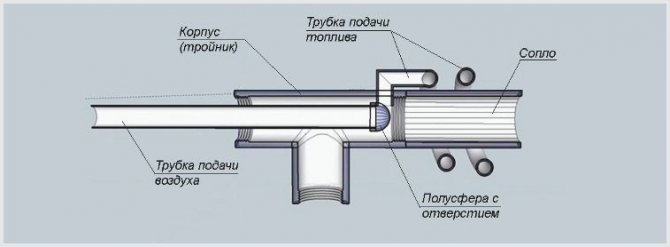

Babington Burner Drawing
The part of the fuel that did not take part in the combustion process flows through the part into the sump, and from there - again into the fuel tank.
For the characteristics of a self-made Babington burner to be the best, it must be equipped with a heating system in which the fuel will be heated before entering the surface for work. As a result, it will become more fluid, naturally, the film formed by it will be very thin. Likewise, the degree of atomization will be the highest, so that the burner will not be difficult to ignite and will work at the highest efficiency (the fuel will burn in full).
It is clear from the principle of operation that a filter is not actually required for a Babington burner. Whatever the amount of impurities contained in the fuel, it will work properly. All the same, before refueling the burner, it is better to pass the used oil through a fine mesh.
Burners for gas boilers can be purchased, or you can do it yourself. Do-it-yourself atmospheric burner for a boiler are key conditions for manufacturing and operation.
What to do if the gas column stops lighting up? This information is intended to help you understand the causes and methods of eliminating breakdowns.
A few important details
Many experts advise paying attention to burners when buying them. In particular, their power is important, which must exceed the heating power of the boiler.In addition, it makes sense to pay attention to the type of adjustment. For domestic use, one- and two-stage burners are sufficient. But for a small boiler room, modulated options are better. Some burners cannot operate on several types of fuel. That is why it is advisable to take care of reserve fuel when buying. Therefore, the burner should work equally well on diesel and waste oil. For example, a good choice would be a Lamborghini diesel burner, which is famous not only for its high reliability, but also for the ability to use a wide variety of fuels.
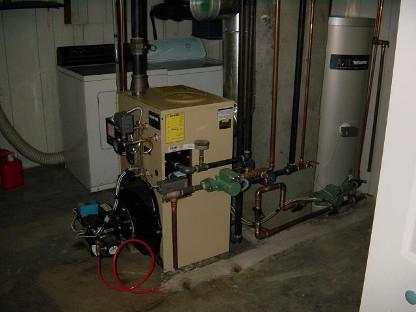

How to install the burner
The burner on a diesel engine should be installed after the boiler and chimney have been installed. The burner installation process also provides for the installation of additional equipment, namely, a fuel tank with a float, a filter, a pump, a piping system, a compressor, a fan and a burner with control modes and an ignition system.
Some diesel burners have all the necessary elements and therefore such burners do not require the installation of additional equipment.
It depends on how correctly the burner is installed, whether the operation of the entire heating boiler will be effective and safe. Therefore, for a competently executed burner installation, you should adhere to the rules for installation work. And it is more desirable to seek the services of professional craftsmen.
Stepless and modulating equipment
In sliding-stage plants, in contrast to two-stage plants, the flame temperature is controlled within a user-defined range. The increase in operating power occurs gradually as the boiler cools down, and not abruptly. This results in lower fuel consumption and lower maintenance costs. The disadvantages of the systems are the high cost and high requirements for the power grid - it must be stable.
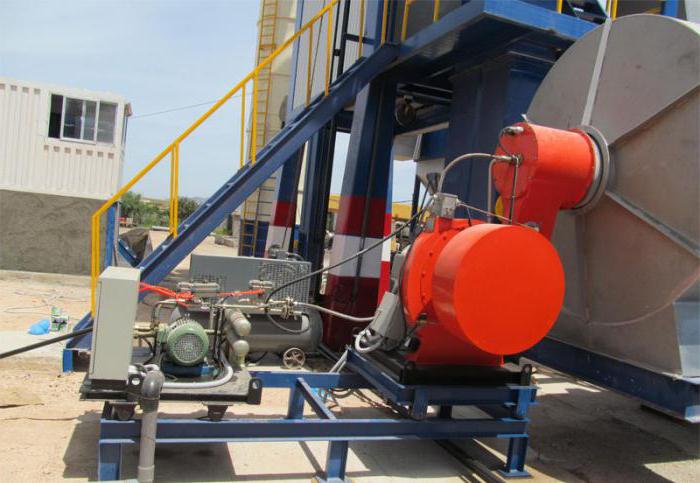

Modulating designs are the most economical and convenient options available for installation in a diesel boiler. Heating is controlled by microprocessor technology, which measures the air temperature in the room, the state of the combustible mixture and gives a signal when the flame power increases or decreases. Significant disadvantages are high price, complex design, high maintenance costs.
One- and two-stage installations
The single stage burner is a classic design installed in a diesel boiler. Heating through such an installation is not the most convenient, but the most reliable. The thing is that the one-stage system works only in one mode - at 100% power.
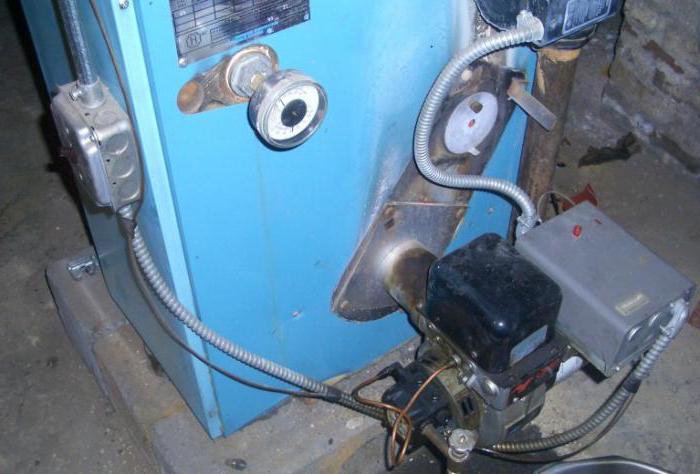

To control the heating temperature of the coolant, it is necessary to periodically turn on / off the burner. Hence, the main disadvantage follows - high fuel consumption. The main advantages of a single-stage design are:
- Simple design, which determines its durability and maintainability.
- Low cost and low maintenance costs.
- Less dependence on automation systems.
The two-stage burner operates in two modes. These can be modes 30/100% power, or 40/100%. The principle of operation of such structures is simple - at 100% heating of the coolant, the automation gives a signal to reduce the flame intensity to 30% or 40%. After the boiler cools down to a certain temperature, the burner starts operating normally.
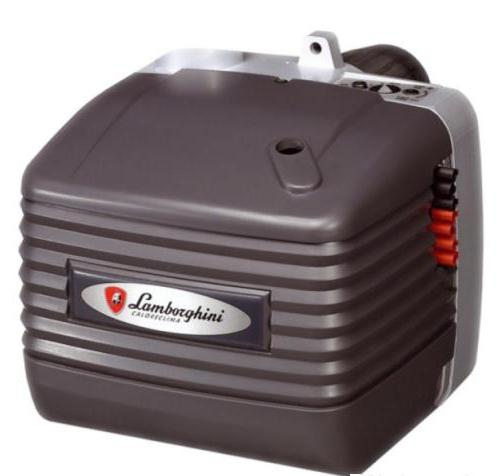

The main advantages of such burners are efficiency and autonomy. Disadvantages - higher cost and higher maintenance costs, lower reliability and durability, due to the presence of automation. A typical representative of this category of devices is the Lamborghini diesel burner.
